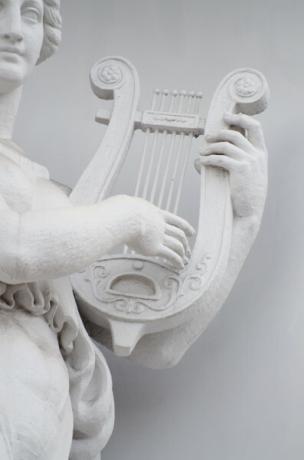The First Generation of Modernism in Portugal, Orphism, Orpheism or Orpheu's Generation, comprises the period between 1915 and 1927.
This name comes from the magazine Orpheu, whose publication in March 1915, in Lisbon, registers the landmark of Portuguese modernism.
Features
Scandal, provocations, influences from the aesthetic currents that developed in Europe, especially Futurism and Cubism, motivated the launch of the magazine, as well as the avant-garde movement in Portugal. These are Orpheu Magazine's trademarks.
The magazine's name is a reference to the Greek myth of Orpheus, a poet who enchanted everyone by playing his lyre, from trees, gods and monsters. Through the lyre, Orpheus was able to calm and promote, in things and people, new attitudes, which is why he represents his regeneration.
Read too: Modernism in Portugal.
Consequences
The target of harsh criticism, it was said that the quarterly magazine portrayed the decadence of literature. For some, it was decadent symbolism itself.
Although only two issues of this magazine have been published, its repercussion was so remarkable that the manifestos followed for another decade in this period, which resembled a modernist revolution.
Other magazines published were: Exílio e Centauro (1916), Portugal Futurista (1917) and Athena (1924-1925).
Thus, Orpheu influenced Portuguese literature and the magazine is still remembered today. The ephemerality of this publication resulted from the lack of money to promote its maintenance.
Artists
Fernando Pessoa, Mário de Sá-Carneiro, Almada Negreiros, Luís de Montalvor and the Brazilian Ronald de Carvalho were members of the Orpheu Generation.
The first issue of the magazine was directed by Luís de Montalvor and Ronald de Carvalho. The second had as directors Fernando Pessoa and Mário de Sá-Carneiro.
Among the Portuguese modernists, without a doubt, Fernando Pessoa stands out. Like Camões, Pessoa is considered one of the greatest Portuguese poets.
Fernando Pessoa created more than seventy heteronyms, the best known being Alberto Caeiro, Ricardo Reis and Álvaro de Campos. Álvaro de Campos' work was featured in Orpheu magazine with the publication of the poem Ode Triunfal:
In the painful light of the factory's large electric lamps
I have a fever and I write.
I write gritting my teeth, beast for the beauty of it,
For the beauty of it totally unknown to the ancients.
read Fernando Pessoa's heteronyms.
presence
The Presença Magazine marks the beginning of the Second Generation of Modernism in Portugal, in 1927. Fifty-four issues of this magazine were published over the period known as presence, which ends in 1940.
During this period, the highlights were: José Régio, José Rodrigues Miguéis and Branquinho da Fonseca.
After the presence, the neorealism, which covers the period 1940-1947).

